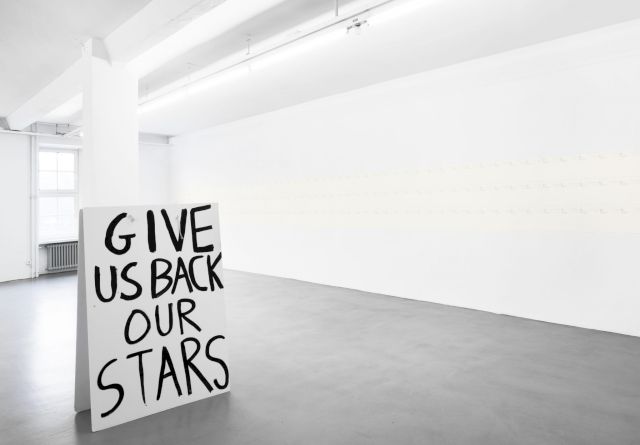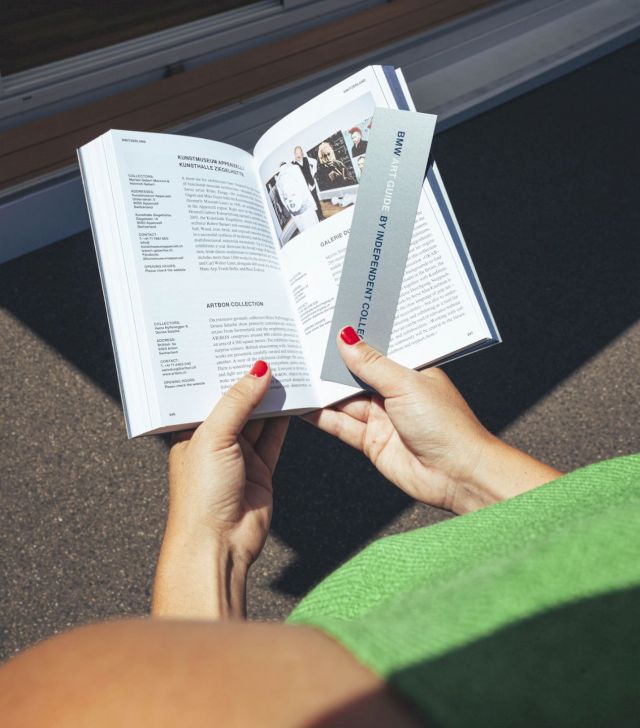The BMW Art Guide by Independent Collectors
The 7th edition of the BMW Art Guide by Independent Collectors takes you to more than 304 collections in 51 countries and 224 cities.

A Letter by Laurie Rojas
I address you, dear patrons of tomorrow, inspired by the art critic Clement Greenberg, who famously wrote that avantgarde art is tied to the bourgeoisie by an »umbilical cord of gold.« At a time when modern global society is experiencing war on the doorstep of Europe, an endless global pandemic, and rising inflation and unemployment, it should come as no surprise that this unprecedented uncertainty overwhelms all creative minds—those who are the most vulnerable in times of crisis. That is why, if it is to survive, your unique assets are of utmost importance for the future of artistic production.
I will not supply rules of ethics and codes of conduct, as has become fashionable in collecting discourse; I will leave it to other experts to monopolize the advice of the business of collecting. I will rather engage in nurturing your enthusiasm in supporting good art, your worldly sensibility, curiosity, and connoisseurship, just as I would do for any aspiring art critic.
When the image of the next five years is obscure, when the market confidence in emerging artists is faltering, what is to be done? Seek out the expression of the imagination and support practices with a sense of artistic possibility and the determination to express it as forcefully and distinctly as possible. Only a few dozen artists fit this bill at any given moment—this is perhaps the biggest minority to be found—but nourishing a strong aesthetic sensibility in times of tumultuous transformation is necessary, for when art appears the least relevant, it might be the most needed. Patrons and critics need to support the art ecosystem as it evolves: to encourage independent and critical thinking, to promote freedom, and to champion ambitious works with aesthetic power, as well as the resources that grant artists and critics free time and autonomy.
Where to begin?
Patronage models are slow in evolving and sometimes last a century or more. The first major world-historical change in patronage was during the Renaissance, which granted artists freedom from having to produce propaganda or decoration for the Church and State, their only patrons for centuries. The crisis of old institutions in the late Middle Ages paved the way for the emergence of a new class of wealthy, educated individuals who became patrons of artists and thinkers, epitomized by the Medici in Florence. It was a world-historic crisis that opened-up the possibility for artists to emancipate themselves from the guilds, therefore allowing them to become more autonomous and yet more meaningfully entrenched in society as a whole.
The autonomy of art, aesthetically and in terms of its subject matter, was founded on a new social situation for artists and intellectuals. After the modernization of the world, the French and American Revolutions, this autonomy became more vigorous. The art historian and critic TJ Clark treats Jacques Louis David’s Death of Marat (1793) as the exemplification of a masterpiece that became unhinged from aristocratic patronage and joined the masses in the streets during the French Revolution. The painting epitomizes the further development of freedom and autonomy of art in modernity, while also becoming a new form of public address.
The social condition of art in modernity is that art must continually remake itself in a world that is constantly changing. This is why the new is rarely new, but the old in distress, because art is the most affected in a world that is constantly changing, it wants to continually remake and rethink itself. But this is also why the 19th-century German poet and philosopher Friedrich Schiller would call art the daughter of freedom, and Theodor Adorno would call art the ambassador of freedom in the late 1960s.
How does art patronage help to gradually move towards more artistic freedom? By granting artists and thinkers autonomy and access to a sustainable ecosystem. For example, the Knight Foundation, which operates in American cities such as Detroit and Miami, supports not only big institutions but grassroots organization and individual projects on the quality of the idea and allows for those who are already active in the community to do more, for gallery and non-gallery affiliated artists to create artworks, but freely, without political agendas. Beyond artworks and art commissions, the Knight Foundation supports a wide range of initiatives: from staff positions and operating support to technology-driven projects, from sustainability of artists residencies to digital commissions, and everything in between.
A major vanguard of holistic patronage models has formed around Latin American art collections, which have diversified their support of the art ecosystem. The New York based Venezuelan philanthropist Patricia Phelps de Cisneros not only sits on the board of major American and European museums and donated works to their collections, but has been experimenting with ways of creating a bilingual (Spanish and English) and profoundly inclusive patronage model. The foundation supports conservation initiatives for Latin American modern masters, while also hosts online debates and public conversations that engage intellectually rigorous topics with artists, curators, and critics.
Meanwhile, the Brazilian collector Pedro Barbosa in São Paulo, beyond supporting individual artists and a decades-long effort to create a major archive on ephemeral media, artists’ books and performance art, the coleção moraes-barbosa has fostered transatlantic artistic and curatorial initiatives, created artist and curator/critic residencies and exhibition spaces focused on performance art, which welcome curators, artists and critics to experiment and continually remake its collection displays.
The art patrons of tomorrow can, just like critics, reflect on how art can herald a time of new humans that are self-determining, have freedom of the imagination and spontaneity, and are thus open to possibilities that in the present seem foreclosed.
About the author:
Laurie Rojas is an independent art critic and lecturer based in Berlin and Miami. In addition to her writing on criticism, museums, art market, and exhibitions, she has also lectured on the history of art and its relationship to politics. She is the former senior editor of Spike Art Magazine, where she organized and moderated a panel on Cancel Culture. She founded the new art and criticism publication, Caesura, a non-academic publication dedicated to art, poetry, and criticism. Her writing has been featured in The Art Newspaper, Artsy, Artnet, Artforum, Chicago Art Criticism, Time Out Chicago, The Nation, The New Yorker, Sotheby’s Magazine, Arts of the Working Class, Kunst und Auktionen, among others.
The 7th edition of the BMW Art Guide by Independent Collectors takes you to more than 304 collections in 51 countries and 224 cities.
